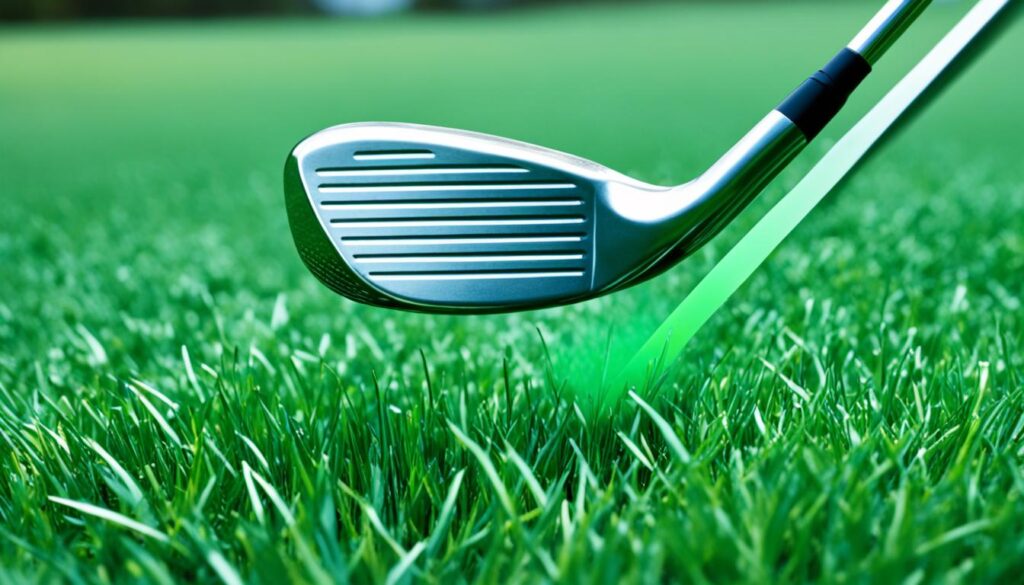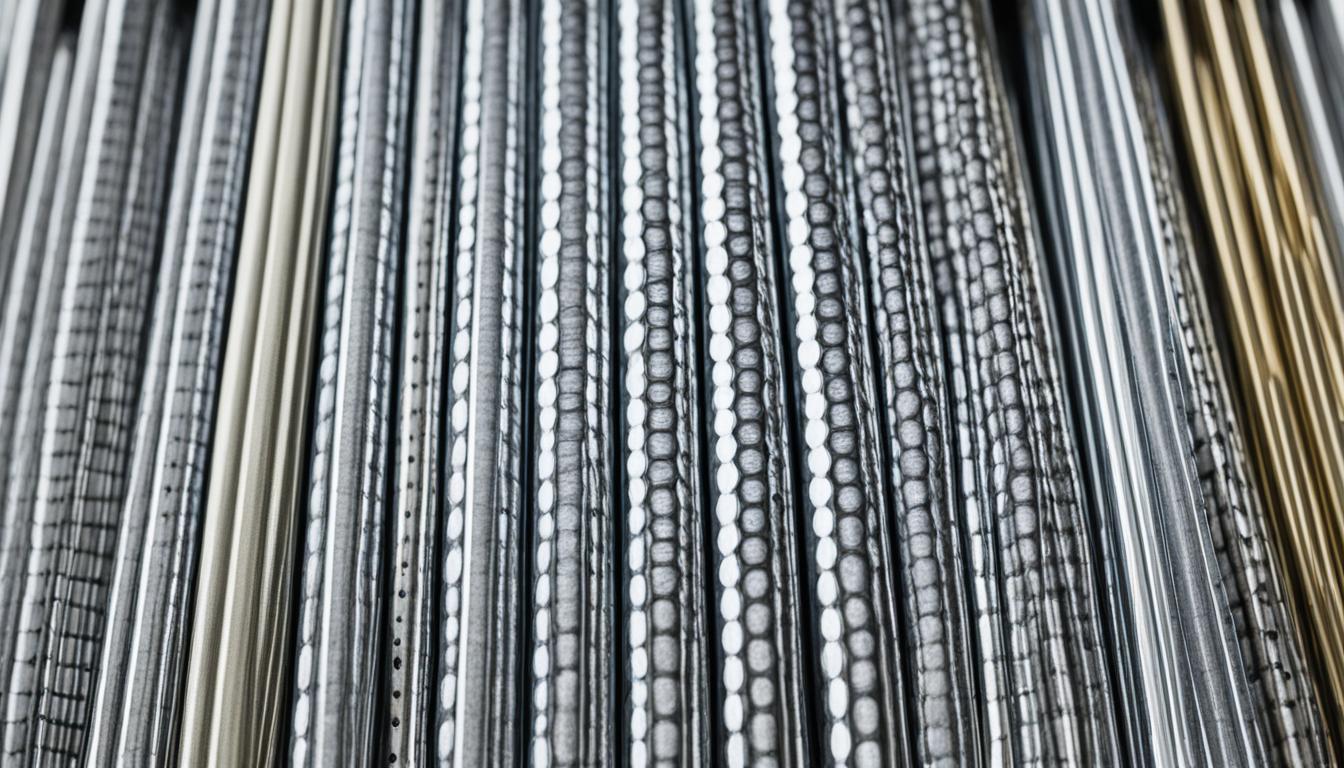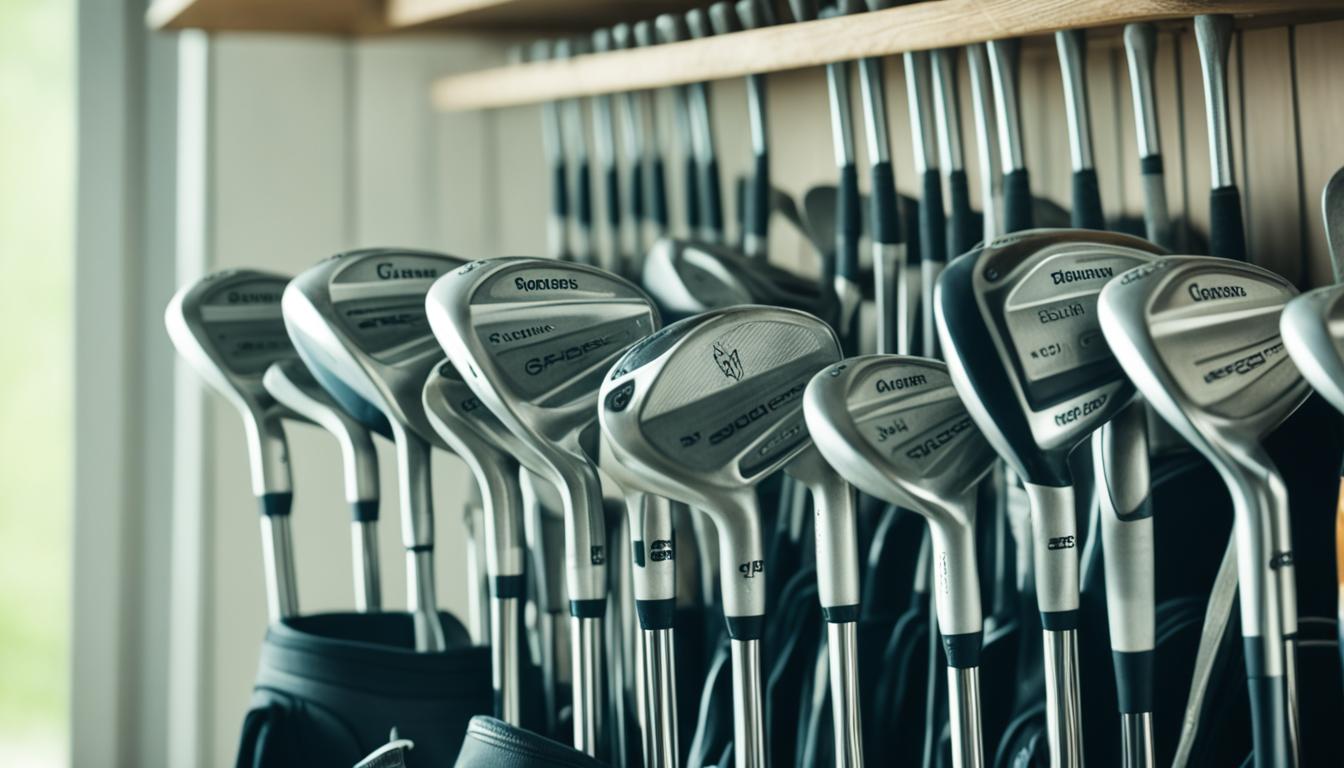The golf shaft is a critical component of your golf clubs, influencing factors such as trajectory, spin rate, distance, and accuracy. It is important to understand the different materials, flex options, and lengths available to choose the right golf shaft that suits your swing and playing style.
Key Takeaways:
- Choosing the right golf shaft is crucial for optimal performance on the course.
- Golf shaft materials, such as steel and graphite, offer different characteristics and performance benefits.
- Shaft flex determines how much the shaft bends during the swing and should be selected based on swing speed and playing style.
- Golf shaft weight affects swing synchronization, balance, and consistency.
- Shaft length can impact shot distance and accuracy, and should be considered based on factors such as height and wrist-to-floor measurement.
Types of Golf Shaft Materials
When selecting a golf shaft, it’s crucial to understand the different materials available and how they can impact your game. Golf shafts are typically made from two main materials: steel and graphite. Each material offers unique characteristics that cater to different player preferences and gameplay styles.
Steel Shafts
Steel shafts are known for their durability and strength. They provide excellent control and accuracy, making them a popular choice among seasoned golfers. With a heavier weight, steel shafts offer stability and can help promote a more consistent swing. They are ideal for players who prioritize precision over extreme distance. Golfers who prefer a more traditional feel and enjoy a smooth feedback through their swings often opt for steel shafts.
Graphite Shafts
Graphite shafts, on the other hand, are lighter in weight compared to steel shafts. This lighter construction allows for increased swing speed, generating more distance and potential power. Graphite shafts are often chosen by players who have slower swing speeds, as the lighter weight can help compensate for the lack of power. These shafts also provide enhanced vibration dampening, offering a more comfortable experience during impact. Golfers seeking more distance and a softer feel may lean towards graphite shafts.
Multi-Material Shafts
Some golf shafts combine the best of both worlds by incorporating a combination of steel and graphite materials. These multi-material shafts aim to optimize performance by leveraging the benefits of each material. By strategically placing steel and graphite sections throughout the shaft, manufacturers can fine-tune characteristics such as weight distribution, feel, and performance. Multi-material shafts offer a balanced blend of control, distance, and forgiveness.
Titanium Shafts
Titanium shafts are a niche option that appeals to golfers seeking lightweight shafts with significant rigidity. These shafts are lighter than both steel and graphite, allowing for increased swing speed. However, titanium shafts can feel stiffer than other options. Golfers with fast swing speeds who prioritize maximum distance may choose titanium shafts to harness the lightweight advantage.
Nanofuse Shafts
Nanofuse shafts represent the cutting edge of golf shaft technology. These shafts feature a unique composition that combines a nanocrystalline alloy with a carbon fiber composite polymer. The result is a shaft that offers enhanced strength, improved energy transfer, and a responsive feel. Nanofuse shafts are designed to provide consistent performance and durability, allowing golfers to optimize their swing and maximize their potential on the course.
Understanding the different golf shaft materials is key to selecting the right shaft for your game. Whether you prioritize control, distance, or a combination of both, there is a material that can align with your needs and preferences. Next, we will delve deeper into the importance of golf shaft flex and how it can impact your swing and gameplay.
Understanding Golf Shaft Flex
Shaft flex is a crucial factor to consider when selecting the right golf shaft for your game. It refers to the ability of the shaft to bend during the swing, impacting the performance and feel of your shots. Understanding flex ratings, stiffness, swing speed, and kick point can help you make an informed decision.
Flex ratings range from Ladies (L) to Extra-Stiff (XS), with options in between like Regular (R), Stiff (S), and Senior (A). The flex rating indicates how much the shaft will bend under the force of your swing. For players with faster swing speeds, a stiffer flex is recommended to control the shaft’s bending and maximize accuracy. On the other hand, players with slower swing speeds may benefit from a more flexible shaft to generate more power and distance.
When considering the right flex, it’s important to take into account your swing speed. A general guideline is that players with swing speeds below 90 mph should opt for a more flexible shaft, while those with swing speeds above 90 mph should lean towards a stiffer flex. However, individual preferences and playing style also come into play, so it’s essential to experiment and find the flex that feels the most comfortable and delivers optimal results for your game.
Stiffness is another factor to consider alongside flex. While flex refers to the overall bendiness of the shaft, stiffness describes how much of that bending occurs in different regions of the shaft. Different shaft models will have different stiffness profiles, allowing you to find the one that suits your swing characteristics.
The kick point, also known as the flex point, is the point on the shaft where the majority of the bending occurs during the swing. It influences the trajectory of your shots. Low kick point shafts tend to produce a higher ball flight with more spin, while high kick point shafts tend to produce a lower ball flight with less spin. Selecting the right kick point can help you achieve the desired shot shape and trajectory.
Remember, finding the right golf shaft flex requires careful consideration of your swing speed, playing style, and personal preferences. Working with a professional club fitter or consulting reliable sources can provide valuable insights and guidance in choosing the appropriate flex that optimizes your performance on the course.

Quote: “Choosing the correct shaft flex can greatly impact your game. It’s like having the right tool for the job – it allows you to maximize your potential and achieve consistent results.” – Golf Pro
| Flex Rating | Description |
|---|---|
| Ladies (L) | The most flexible flex rating, suitable for players with slower swing speeds |
| Regular (R) | A balanced flex rating, suitable for a wide range of swing speeds |
| Stiff (S) | A less flexible flex rating, suitable for players with faster swing speeds |
| Senior (A) | Between Regular and Ladies flex, suitable for players with moderate swing speeds |
| Extra-Stiff (XS) | The least flexible flex rating, suitable for players with very fast swing speeds |
Importance of Golf Shaft Weight
The weight of the golf shaft plays a crucial role in enhancing your performance on the course. It affects not only your swing synchronization but also the balance and consistency of your shots. When selecting a golf shaft, one of the key considerations is the material it is made of. While steel and graphite are the most common options, their weight characteristics differ significantly.
Steel Shafts:
Steel shafts are known for their durability and provide excellent stability and control. They are typically heavier than graphite shafts, which can help golfers maintain a consistent swing tempo. The added weight in steel shafts allows for better shot shaping and increased accuracy, making them a preferred choice for players who value control over distance.
Graphite Shafts:
On the other hand, graphite shafts are lighter, allowing for increased swing speed and distance. The lower weight can help golfers generate more clubhead speed, resulting in powerful drives and longer shots. Graphite shafts are often popular among players with slower swing speeds or those seeking maximum distance to optimize their game.
Choosing the right weight for your golf shaft depends on several factors, including your swing speed, tempo, and personal preference. It’s essential to find a balance between control and distance based on your individual playing style. Consulting with a club fitting professional can provide valuable insights and guidance to help narrow down your options.
Weight distribution within the shaft also plays a crucial role in optimizing performance and feel. The distribution can vary based on factors such as shaft material, design, and manufacturing process. Some shafts may have different weight properties in specific areas, such as the tip or butt. Achieving proper weight distribution ensures a balanced club that complements your swing mechanics and delivers consistent results.
Ultimately, the weight of your golf shaft has a direct impact on your overall game. Prioritize finding the right weight distribution that matches your swing and enhances your performance. Consider factors such as control, distance, and personal preference to make an informed decision when selecting your ideal golf shaft.
Golf Shaft Weight Comparison
| Golf Shaft Material | Weight Characteristics |
|---|---|
| Steel Shafts | Heavier weight for stability and control |
| Graphite Shafts | Lighter weight for increased swing speed and distance |
Golf Shaft Length Recommendations
The length of the golf shaft plays a crucial role in determining shot distance and accuracy. Finding the right length for your golf clubs can greatly improve your game. While longer shafts have the potential to increase distance, they may also impact control. On the other hand, shorter shafts offer improved control but may sacrifice some distance.
When considering the ideal golf shaft length, there are a few factors to keep in mind. One important consideration is your height measurement. Taller players may benefit from longer shafts, while shorter players may find better results with shorter shafts.
Another factor to consider is the type of club. Driver shaft length, for example, typically differs from the shaft length recommended for irons. Drivers often have longer shafts to promote distance, while iron shafts are generally shorter to enhance control and accuracy.
To determine the right golf shaft length for your game, it is recommended to use a wrist-to-floor measurement. This measurement helps account for individual swing dynamics and can provide valuable guidance in finding the optimal shaft length.
It is important to note that these are general recommendations, and individual preferences may vary. Custom fitting or consulting a professional club fitter can provide personalized recommendations based on your specific needs and playing style. They have the expertise to analyze your swing and make precise adjustments to optimize your performance.
| Height (inches) | Club Type | Recommended Shaft Length (inches) |
|---|---|---|
| 60 – 64 | Driver | 44 – 45 |
| 60 – 64 | Irons | 37.5 – 39 |
| 65 – 68 | Driver | 45 – 46 |
| 65 – 68 | Irons | 36.5 – 38 |
| 69 – 72 | Driver | 46 – 47 |
| 69 – 72 | Irons | 36 – 37.5 |
Remember, finding the right golf shaft length can significantly impact your game. Whether you choose to follow general recommendations or seek expert advice, optimizing your shaft length based on your height measurement and playing style can help you achieve better distance and accuracy on the course.
Selecting the Right Golf Shaft for Your Game
When it comes to choosing the right golf shaft, there are several factors to consider, including your swing speed, playing style, and personal preferences. Finding the perfect match can greatly enhance your ball flight, distance, and accuracy on the course. To ensure you make the best decision, it’s recommended to work with a professional club fitter or conduct personal trials with different shafts.
A professional club fitter has the expertise and specialized tools to analyze your swing mechanics, tempo, downswing force, release point, and desired ball flight. By taking these factors into consideration, they can provide valuable insights and guidance on which golf shaft will suit your game the best.
Working with a professional club fitter allows you to tap into their extensive knowledge and experience. They can offer valuable advice on the right shaft options for your swing and playing style, taking into consideration important variables such as your swing speed and shot trajectory preferences.
Personal experimentation is also key in this process. Trying out different golf shafts allows you to gauge how they feel and perform with your particular swing. By testing various options, you can pinpoint the one that feels the most comfortable and produces optimal results.
During your experimentation phase, pay attention to how the different shafts affect your ball flight, distance, and accuracy. Take note of the feedback your body provides and how it responds to the various shafts. This information will guide you in making an informed decision.
Benefits of Club Fitting
Club fitting is a valuable process that can greatly enhance your overall golfing experience. It takes into account your individual swing characteristics and helps optimize your equipment for maximum performance. Through club fitting, you can discover the ideal golf shaft that complements your swing and suits your playing style.
- Improved accuracy and consistency
- Enhanced distance and ball flight
- Increased confidence in your equipment
Club fitting is an investment in your game, ensuring that you’re equipped with the right tools to achieve your goals on the course. So, don’t hesitate to consult with a professional club fitter and explore the wide range of golf shaft options available. The right fit can make all the difference in your golfing journey.

| Golf Shaft Selection Factors | Considerations |
|---|---|
| Swing Speed | Choose a shaft with an appropriate flex that matches your swing speed. Faster swing speeds generally require stiffer shafts, while slower swing speeds benefit from more flex. |
| Playing Style | Consider your playing style, whether you prefer a more aggressive or smooth tempo. This can influence the recommended golf shaft characteristics, such as kick point and weight. |
| Personal Preferences | Take your personal preferences into account, such as the feel and control you desire from your golf shaft. Weight, material, and overall aesthetics are all aspects to consider. |
Conclusion
Selecting the right golf shaft is crucial to maximize your performance on the golf course. When choosing a golf shaft, consider important factors such as the material, flex, weight, and length to ensure it matches your unique swing and playing style. By taking these factors into account, you can optimize your shots and improve your overall game.
Custom golf shaft options provide additional opportunities to tailor your clubs to your specific needs. Whether you require a specialized flex or a custom weight distribution, there are options available to enhance your playing experience. Consulting with a professional club fitter can provide valuable insights and guidance to help you make the best selection. Their expertise and knowledge will ensure that you find a golf shaft that perfectly suits your requirements.
Once you have narrowed down your options, it’s essential to take the time to experiment with different shafts. Testing various combinations of materials, flexes, and weights will allow you to find the ideal fit for your swing and playing style. It may require some trial and error, but the effort will be well worth it when you find the perfect golf shaft that unlocks your full potential on the course.
So, remember to consider the custom golf shaft options available, think about your golf club shaft selection carefully, and follow these golf shaft fitting tips. By doing so, you’ll be well on your way to selecting the ideal golf shaft that will elevate your game and provide you with a personalized and enjoyable golfing experience.
FAQ
What are the different types of golf shaft materials?
Golf shafts can be made from steel, graphite, multi-materials (steel and graphite), titanium, or nanofuse materials.
What is the significance of golf shaft flex?
Golf shaft flex refers to the ability of the shaft to bend during the swing. It is important in determining factors such as trajectory and shot accuracy. The flex options range from Ladies (L) to Extra-Stiff (XS).
How does the weight of the golf shaft impact performance?
The weight of the golf shaft affects swing synchronization, balance, and consistency. Steel shafts provide stability and control, while graphite shafts offer increased swing speed and distance.
What is the impact of golf shaft length on performance?
The length of the golf shaft can affect shot distance and accuracy. Longer shafts may increase distance but affect control, while shorter shafts improve control but may reduce distance. The ideal shaft length can vary based on factors such as height and wrist-to-floor measurement.
How should I select the right golf shaft for my game?
Selecting the right golf shaft involves considering factors such as swing speed, playing style, and personal preferences. Working with a professional club fitter or experimenting with different shafts can help determine the best fit for enhanced performance.
Are there custom golf shaft options available?
Yes, there are custom golf shaft options available to tailor your clubs to your specific needs. Consulting a professional club fitter and exploring different shaft choices can further optimize your golfing experience.



